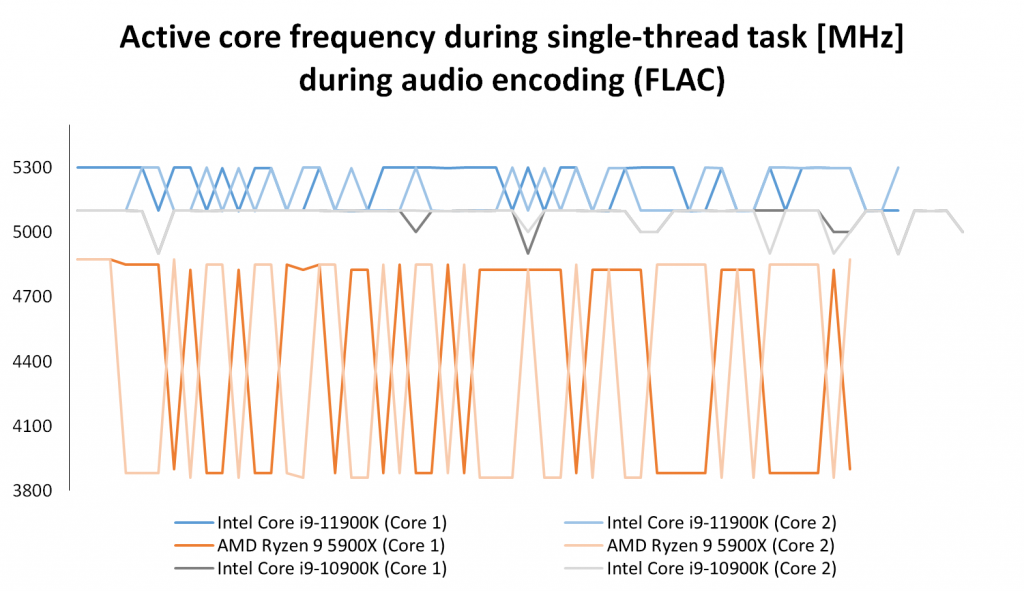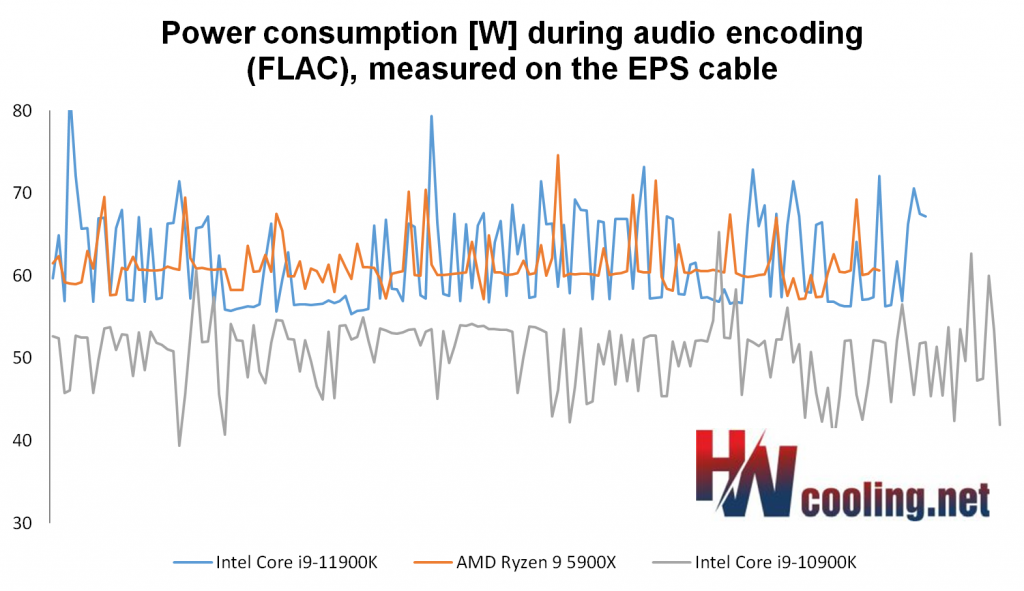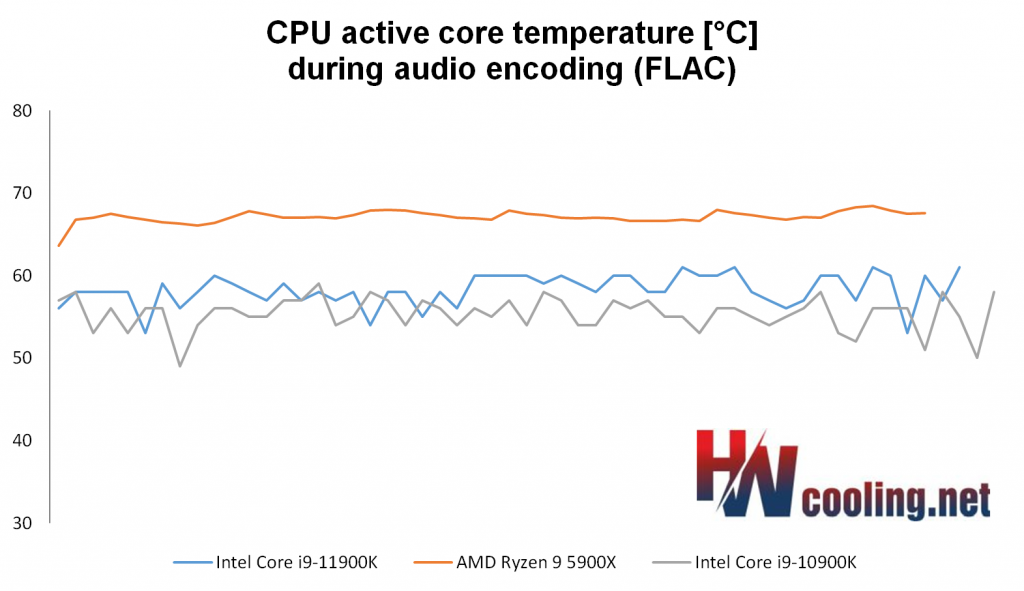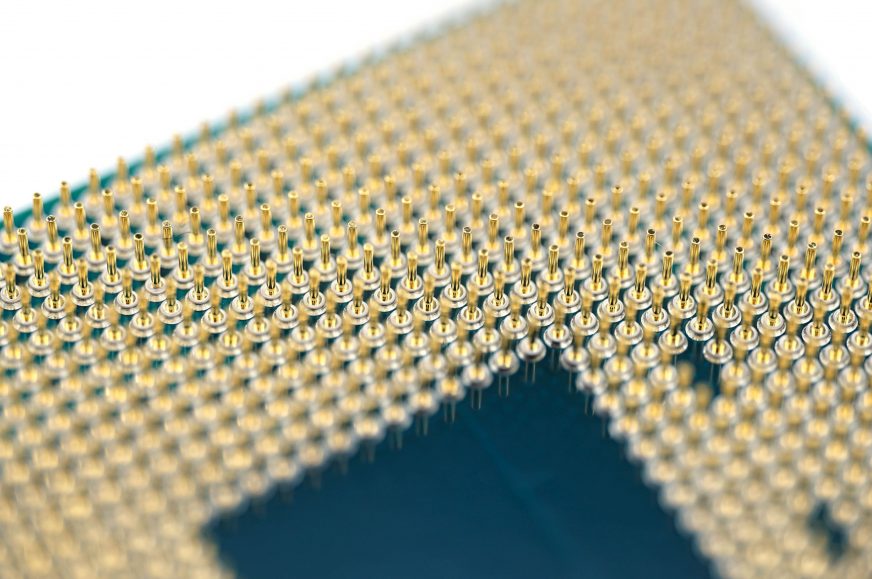Comparison of Ryzen 9 5900X, Core i9-11900K and Core i9-10900K single-thread boost operation
In a recent test of processors, we focused on everything, even single-threaded boost. We will now take a closer look at it, because its behavior is remarkable. Modern processors also use two cores in turns for single-threaded tasks. This creates a short pause for the unloaded core to cool down. We captured how it works in bar graphs with waveforms, and you will also find out whether the specifications are closer met by AMD or Intel.
For single-threaded tasks, processors reach their maximum specified boost clock. We measure how high these clocks are in one of the audio encoding (FLAC) tests. In standard tests, we plot the final average value in the bar graphs, but it also makes sense to pay attention to the trend of clock speed throughout the entire test.
Before we look at it, let’s start with a graph of the performance that the processors achieve in this test. The Ryzen 9 5900X has a small advantage over the Core i9-11900K in FLAC encoding (reference encoder 1.3.2), but in other cases (like encoding other compression formats by other encoders), it may be the other way around.
In two of the four audio encoding tests, Rocket Lake is the winner again. But the performance differences are not that important in this article. Power consumption is always very similar and the maximum boost of processors behaves similarly across these tests. What we will follow in detail in this article is its trend under the load.
At first, the behavior of the boost confused us a bit, and that’s why we first misinterpreted it in standard graphs. The results were based on the average clock speed of the most active core. But it’s two of them that are active. Although one is always a little more active (and on average reaches higher clock speed), the secondary core, which also contributes significantly to the result, is not that much slower.
The graph below also shows how the cores take turns in achieving the maximum clock speed. On the AMD Ryzen 9 5900X and Intel Core i9-11900K, the maximum clock speed is never reached by both cores at the same time, but they take turns. When one core is at its maximum, the other will decrease its frequency and vice versa. And that’s a pretty handy clock and power management. If the maximum clock speed were maintained on only one core continuously, the temperature would be higher, which would lead to lower final clock speed and thus lower performance.

The clock rate is affected by the temperature. After exceeding 70 °C, the Thermal Velocity Boost reduces the achieved clock speed from 5.3 GHz to 5.2 GHz. In this method with alternating cores, the temperature is naturally lower, which creates some reserve even for weaker coolers. In any case, a better cooler is always required, which is quite funny in the context of roughly 60 W single-threaded power consumption. However, cooling such a small area, where the two more active cores are, is relatively difficult. Especially for AMD processors with 7 nm chiplets.

This test also nicely shows that with the same power consumption, the AMD processor heats up significantly more and basically even with the powerful Noctua NH-U14S cooler (at max. 1,500 rpm) at 68 °C, we are not sure whether the maximum possible clock speed for single-threaded load is achieved. AMD does not specify temperature limits as accurately as Intel, but nevertheless exceeds the paper specs by 40 MHz. The official value for the maximum boost (on 1–2 cores) is set at 4.8 GHz for the Ryzen 9 5900X. In our tests, it is up to 4,843 MHz on average, but the clock rate could unofficially max at 4.95 GHz, even without active PBO2.

Conversely, Intel lacks a bit to reach 5.3 GHz on average. Although this frequency is achieved, it represents the maximum, and if we take into account the occasional drops to 5.2 GHz, the average is 5,257 MHz, i.e. for 43 MHz below the value that Intel states for max. boost. The operation of the Core i9-10900K, which also supports TVB, is also remarkable, so the clock speed of 5.3 GHz should also be achieved. According to the specifications, these two Core i9 models do not differ intergenerationally. Nevertheless, the maximum frequency of Comet Lake (Ci9-10900K) is significantly lower than that of Rocket Lake (Ci9-11900K).
Comet Lake does not reach 5.3 GHz and operates at frequencies corresponding to Turbo Boost 2.0. So it seems that Intel has tuned its newer processor better in this regard, but of course, it can not be ruled out that the processor will behave differently and reach higher frequency for one or two cores on a motherboard other than the one we use for tests – (MSI MEG Z490 Ace).
- Contents
- Comparison of Ryzen 9 5900X, Core i9-11900K and Core i9-10900K single-thread boost operation











